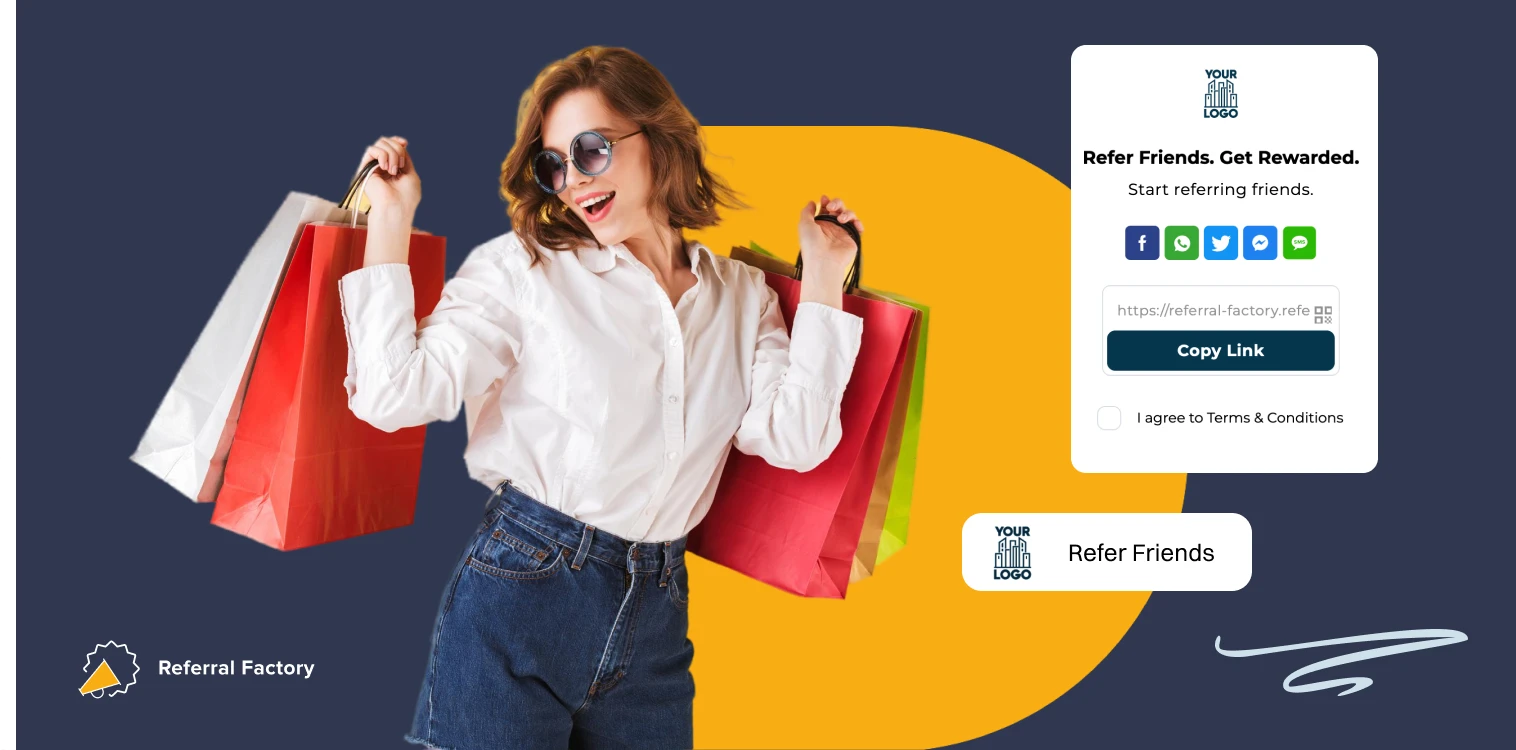Customer Referrals [A CMO’s Guide To Referral Marketing]
We’ve all heard the success stories of startups like PayPal, Dropbox, Uber, and Revolut, who used referral programs to accelerate their growth towards unicorn status. Some of these companies even attribute over 50% of their growth to customer referrals!
The concept of asking your customers to “refer a friend” isn’t new — it’s just the shinier model of an age-old marketing channel companies have relied on for decades: word of mouth. The only real difference between word of mouth then and now, is how it happens. In the 1940s, a housewife leaned over her garden fence and discussed the new range of clothing that arrived at the local boutique. Fast forward to 2023, when users of a neo-bank are each prompted to share a referral link with friends via a direct message.
Referral marketing is often thought of as a growth channel that can only be executed by innovative startups, which is crazy because that couldn’t be farther from the truth! Large organizations are actually more likely to succeed with referral marketing than any other type of company.
These are the key ingredients you need to launch a successful referral program:
- A well-established and trusted brand… because people don’t want to refer their friends to something they don’t believe in.
- A large customer base to ask for referrals… because, let’s face it, volume counts in this game.
- Budget for rewards and incentives… because the best kickbacks drive the best behavior.
If you look at the three main factors that influence how successful a referral program can be, you’ll see that the older and larger your organization is, the more likely it will be to succeed.
I decided to write this guide for CMOs who have all the right ingredients to achieve overwhelming success by launching a referral program. I truly believe customer referrals should be a priority in every organization, but I also understand there is more complexity when executing a referral marketing strategy in larger companies.
This guide should cover all the main elements you need to overcome those complexities and launch a referral program that could help you acquire a staggering 8%-22% more customers annually!
Let’s dive in 🤿
Table of Contents
What Exactly Is Referral Marketing?
Referral marketing is when your happy customers spread the word about your business to their friends and network. They act as advocates for your brand and encourage others to try your product or service too.

The best way to actively encourage your customers to refer their friends is to launch a customer referral program. A referral program is a proactive and systematic approach to encouraging and incentivizing your existing customers to refer their friends, family, and colleagues to your business. It typically involves creating a structured system where customers are rewarded for successfully referring new customers to your company. Referral incentives can include discounts, free products or services, or even cash rewards.
Customer referral programs usually run on an ongoing basis, which means that your existing customers can continue to refer new customers at any time, and those new customers are also enrolled in the referral program, creating a referral loop.
Why Referral Marketing Should Be A Priority for CMOs
I could write 10 paragraphs on this but the bottom line is this…

A study from Texas Tech University found that while 83% of consumers say that they are willing to refer after a positive experience, only 29% actually do.
You do the math: if over half of your customer base is willing to refer their friends but just needs a little prompting, can you afford not to prioritize launching a referral program?
Example Of A Corporate Referral Program
Payment solutions company, UK Fuels, is an excellent example of a corporate customer referral program done right. Here’s an overview of how their program works and the strategies they use to incentivize customers for referrals:
Encouraging advocates and their friends: UK Fuels incentivizes customers to refer businesses by offering existing customers a £25 Amazon Gift Card for successful referrals. Plus, they incentivize the new lead with a matching amount — a £25 discount on their first invoice. To maximize results, they pitch the reward as ‘Give £250, Get £250’. In other words, refer 10 businesses and get £250 in Amazon Gift Cards.

Easy referral process: Even though there’s a substantial reward for referrals, part of the success of UK Fuels’ customer referral program is how easy it is for customers to refer their friends. Customers simply need to sign up for a referral link and then share that link with their network.
Higher quality leads: Referral marketing generally drives high-quality leads because of the level of trust that can be leveraged when a customer recommends your brand, but UK Fuels’ results really drive this home — with a conversion rate of 45.5%!
By leveraging the power of customer referrals and implementing these strategies effectively, your business can experience similar success in driving growth.

Results You Can Expect From A Referral Program
Of course, the primary result you can expect from a customer referral program is an increase in new leads — after all, that’s what you’re asking your customers to do. However, it cannot be stressed enough that the leads who come through a referral program are of much higher quality than other lead sources. And, new business isn’t the only result! Referral programs have knock-on effects on the relationship you have with your existing customer base too.
Increased Sales and Revenue:
Implementing a referral program can lead to a significant increase in sales and revenue because referred leads are inherently more qualified and interested. They come with a degree of trust already established due to the endorsement from someone they know. This higher level of trust translates into shorter sales cycles and higher conversion rates, as the initial skepticism that often accompanies cold leads is minimized, resulting in a direct impact on your bottom line.
Improved Customer Loyalty and Retention:
A well-executed referral program not only attracts new customers but also strengthens existing customer relationships. When customers are rewarded for referring others, they feel valued and appreciated by your brand. This fosters loyalty and encourages them to continue purchasing from you, leading to higher customer retention rates over time.
Expanded Reach and Brand Awareness:
Referral programs have the potential to exponentially expand your reach beyond traditional marketing efforts. By incentivizing customers to refer their friends, family, or colleagues, you tap into their personal networks that may be untapped by other advertising channels. As these referrals engage with your brand, awareness spreads organically, boosting both recognition and credibility in the market.
5 Elements You Need To Implement A Customer Referral Program
The recipe for success when it comes to implementing a customer referral program can be a little daunting. What’s important to remember is that 90% of the effort happens during the program’s setup phase — once it’s launched, you can sit back and watch the results compound.

In this way, executing a customer referral program is a little like working on SEO; it takes some detailed and strategic planning but once in place, the dividends will start to pay back year after year after year. And, rest assured, the results will far outweigh those of any paid ad campaigns.
To make this process easier for you (as a CMO), I’ve listed all the elements you’ll need to cover when planning and launching a customer referral program. If you’d prefer to hire someone with more experience to help guide you through each element, feel free to pop me a message on LinkedIn 💌
1. A Bold Referral Program Strategy
There are several factors to take into account when planning the strategy for your referral program. You’ll need to define what a successful referral is for your business (a purchase, a policy taken out, an account opened, etc.). You’ll also need to decide if you’re launching a double-sided or single-sided program, both types of programs have benefits with the double-sided one being more likely to succeed and the single-sided one being easier to implement.

You’ll also need to think about when and how you’ll prompt customers to refer, and the flows each user will follow to either refer or be referred. This is important to plan because it helps you know what (technical and other) resources you’ll need to bring this to life. Keep in mind that there is enterprise-ready referral program software available, so turning these flows into a real referral program is actually easier than you think 😉
Lastly, you’ll need to choose your rewards and incentives. This is what you’ll use to motivate people to participate in your referral program. The three most popular rewards we see at Referral Factory are:
🎁 A rewards basket with a choice of Amazon Vouchers or Digital Cash Cards
🎁 Discounts or rewards points
🎁 Exclusive, hard to access, perks

2. Solve How To Track And Reward Customer Referrals
Since reputation management of your brand is so important for larger organizations, you simply can’t afford to wing the tracking setup. As the CMO, all eyes will be on you. You want to be sure that all users participating in your referral program have access to real-time tracking of their referrals, and that they are rewarded on time for sending new business your way. You’ll also need to report back to the executive team on the performance of this customer referral initiative. For this reason, you’ll need to plan and test your referral program’s tracking before you launch.
These are the main KPIs you’ll want to track:
📊 Number of users who opt-in to refer (this helps you forecast how many referrals you could generate)
📊 Number of referrals generated (leads acquired)
📊 Number of referrals converted (new customers acquired)
📊 Conversion rate of your referrals (referrals divided by converted referrals)
📊 Channels users are sharing their referral links on (sometimes also called referral codes)
📊 Number of rewards issued (so you can control your rewards budget)
If you use Referral Factory to execute your referral program, you’ll get most of this tracking out the box 👇

Something else you’ll need to think about is where to send these new referred leads when they come in. You might need to set up webhooks or an API integration to funnel your referrals into the business workflows you already use. If you use a CRM (like Salesforce.com or even a custom-built CRM) this should be simple to set up.
3. Make Sure Your Referral Program Is Compliant
This is not something everyone wants to talk about but it’s often the #1 barrier to entry for corporates looking to start generating customer referrals. The larger your organization is, the more pressure there will be on you as a CMO to roll out a program that is compliant and fraud-free.
In this section, I’m going to share the three most important things you can do to avoid fraud and stay within the boundaries of compliance. But, the truth is that every country has different rules! So, if you want a better understanding of regulations related to offering incentives for leads in a specific country, feel free to message me on LinkedIn 💌
Let’s start with the most simple way to comply, which is choosing the correct reward value. In some regions, like Italy and Germany, there are more strict requirements on exactly how much you can pay for a lead before it’s considered solicitation. The good news is that you can often get around this by combining monetary rewards with perks to bolster the value of your referral reward. You should speak to your legal team to understand if your country has a limit on the amount of money you can pay a person (not a company) for a lead. Once you know this, you can plan around it. If this value is low, I’d recommend finding a creative way to push your reward value up. For example, you could offer points that can be redeemed against services you offer. If you make your reward value too low because of these restrictions, you risk the chance of people not having enough of a carrot to motivate them to refer.

The next thing that you’ll need to consider is your referral program’s terms and conditions — making it clear exactly what qualifies as a successful referral and on what timeline a reward will be issued. In many cases, reward payouts are delayed to ensure certain conditions are met. You’ll also need to think about how each user will accept these terms and conditions before they participate in your program. As a corporate, it’s best practice to ask people to opt-in to refer, rather than just sending people referral links to share because it allows you to get explicit consent from your customer to enroll them into your program and send them notifications about their referrals. Since they can agree to terms and conditions during this opt-in process, it covers all your bases! This is an example of how a user would opt in 👇
The final compliance issue I want to cover here is fraud prevention. Not fraud detection. If you’re only picking up fraud after it happens, it’s already too late! So, worry less about fancy ways to detect fraud and more about designing a fraud-proof referral program. If you only reward your referrers for successful or converted referrals, you’re way less likely to get people trying to game the system. And, it’s perfectly normal to hold on issuing rewards until the referred lead is qualified, or even at a short delay thereafter. In fact, if you take stock of the most successful referral programs of all time, you’ll see this is common practice:
Revolut: Get rewarded after your eligible friend signs up using your referral code, opens an account, and deposits at least £500.
Uber: Get rewarded after your friend creates and validates a new account, and actually takes their first trip.
Coinbase: Get rewarded after your friend buys $100 of Bitcoin or more.
See?
It’s totally normal to only pay rewards after certain conditions are met. By designing your program in this way you’ll prevent fraud, so it becomes less important to have tools to detect it.
4. Secure Your Customers Data
A referral program is slightly different from other lead generation campaigns you run because your customers are the marketing channel. This means your customers’ names and emails will be hosted on the software you use to manage your referral program.
For this reason, it’s crucial to make sure you use referral software that gives you the ability to host your own data — it will be near impossible to onboard a SaaS vendor that has a copy of your whole client book! So, your only option is to find a provider that lets you host your own referral program data. If you’re based in Europe, hosting your own data will be mandatory to ensure your program is GDPR compliant.
Here’s an example of how Referral Factory allows enterprise clients to host their own data:

This setup usually takes about a day and will require a developer from your technical team, but once you’re up and running, you’ll have full control of the front end of your program as a marketer. This means you can build and launch as many programs as you want WITHOUT having any ongoing involvement from your tech team!
5. Buy-In From The Executive Team
Given all this complexity, it’s no wonder that customer referral programs tend to be more popular in the startup world. So, why not take a leaf out of their playbook and pitch your customer referral program to the board as an MVP?
An MVP (Minimum Viable Product) is a strategic approach that focuses on creating a basic version of a product or service to test its viability and gather feedback from customers. It’s essentially a pilot! In the context of a customer referral program, pitching it as an MVP allows you to showcase the potential benefits and gather support from the executive team. With Referral Factory, enterprise clients have the ability to run a 3-month paid trial, during which you can try out a customer referral program with a sample of your customers. To get to the point of a trial, however, you’re going to need some data to back your pitch. Luckily, research on referral marketing is increasing and the numbers coming out are impressive. Interested in learning about the stats in your industry? Below is the data from the top-performing 1000 referral programs on Referral Factory by industry. You can see how many referrals were generated on average, based on the number of customers that were asked to refer 👇

Integrating Referral Programs with Existing Marketing Strategies
When you launch your customer referral program, it’s okay to run it independently of your other marketing channels. However, the long-term success of your referral marketing initiative will ride on how well you promote the program. So, think about how you can integrate your customer referral program into as many other channels and customer touchpoints as possible.
For example, incorporate the program into regular communication like newsletters, pop it into your employees’ email signatures, hell, even add the details of your referral program to the bottom of your invoices. You can even use your referral program to further bolster existing customer loyalty by giving shout-outs to your top referrers on your social media channels.
Remember, a customer referral program is typically ongoing, so the goal isn’t to catch every referral on day one. Rather, you want to find ways to keep the referral program top-of-mind when the opportunity comes up for one of your customers to make the recommendation.
Scaling and Managing Referral Programs

The biggest mistake I see companies of all sizes make when they implement referral programs is that they try to go too big too soon. In addition to helping you get your exec team on board, an MVP will also help you get a feel for whether your strategy is hitting the mark. While many marketers typically conduct AB tests on their marketing strategies, this approach does not work the same way with referral programs. Instead, it is better to do a soft launch to a small group — about 10% of your customer base — learn and make adjustments, and then launch the same campaign to a larger audience. Only expand your referral program once you have observed how users engage with it, how your processes work when a potential customer is referred, and have learned from any initial mistakes.
Another reason to consider scaling slowly is that it’s not just the referral program itself and your marketing team who’ll be implicated if you have a sudden burst of referrals! A few years back, I found myself in a seriously conflicted situation with a client who didn’t know whether to kiss me or kill me — we’d announced the launch of their referral program to a significant portion of their customer base and the results were so good that it clogged up their call center for 3 full days, wrecking a fair amount of havoc. So, as you scale, make sure you have the capacity to handle incoming leads as it can quickly become unmanageable.
Once you have launched it out to your entire customer base, managing your referral program should be easy no matter whether you have 100 or 100,000 participants. In fact, the nature of the referral loop — where new referred customers become referrers themselves — means that scaling is very much a part of the game! The best advice I can give you here is to automate as much as possible but keep a human check on the button that issues any rewards, especially if you plan to offer cash or vouchers.
Are There Agencies That Offer Referral Marketing?
Yes and no. Since the industry is still so new, you’ll struggle to find full-scale agencies that focus just on referrals, but you will be able to find consultants and software companies that offer consulting as part of their packages.
Strategic advisory is something we offer all our enterprise clients at Referral Factory because the truth is that there is just so much more complexity when it comes to corporate referral programs. But the good news is that this “early market” means you’re probably already one step ahead of your competitors by even reading this article!
There is also a lot of content available online that can help you educate yourself on referral marketing as a CMO. But let’s face it, being a pioneer has always meant that you’re going into something new with some caution! But, you also get the upside when it works — so, keep in mind that the reward is worth the risk in this case as your chances of success are so high!
A few years from now when every business has a referral program, it will be much harder to compete on rewards, so launching yours first is key to getting the most impact with your referral marketing efforts.
Conclusion
In conclusion, customer referrals are a powerful tool for CMOs looking to enhance their marketing strategies. By implementing a well-designed referral program, businesses can expect increased brand awareness, higher conversion rates, and improved customer loyalty.
It might not be as simple to launch a program as a corporation (especially in comparison to a startup), but, on the other hand, you’re far more likely to succeed and get a great ROI on your efforts because of the fact that you simply have more people to ask to refer. I guess if it was easy to acquire 8%-22% more customers annually, then everyone would be doing it!
Once your program is up and running, don’t forget to integrate it with your existing marketing strategies for maximum impact and the best possible customer experiences. Customer referrals can be a powerful way to drive growth in your organization, so I hope you found everything in this guide to referral marketing valuable and that you feel confident enough to start planning the launch of your own referral program!
You can learn more about the features offered by Referral Factory below. It’s important to note that you can opt to code your own referral program too. Of course designing everything from scratch will give you more flexibility, but a plug and play solution will allow you to move faster as you don’t rely on your engineering team to create, launch, and edit campaigns. Here’s an example of the features you get off the shelf using a plug and play referral software like Referral Factory 👇







